 Spring is in full bloom, birds are chirping, and school’s almost over. It used to be the sign for vacation rental industry professionals to get ready for the busy summer holiday season. Except this year, it’s different. Yes, yes, we all know why (which is why we’ve made a conscious effort to refrain using that 5-lettered-2-numbered word that caused cancellations to rise by 500% in March.) By mid-March, it seemed the vacation rental industry had come to a screeching halt.
Spring is in full bloom, birds are chirping, and school’s almost over. It used to be the sign for vacation rental industry professionals to get ready for the busy summer holiday season. Except this year, it’s different. Yes, yes, we all know why (which is why we’ve made a conscious effort to refrain using that 5-lettered-2-numbered word that caused cancellations to rise by 500% in March.) By mid-March, it seemed the vacation rental industry had come to a screeching halt.
However, as cancelations were spiking, we noticed a blip on the radar. Some of our clients reported boosts in bookings. Domestic travelers were escaping cities and sheltering in vacation rentals to wait out the pandemic. As many in the industry predicted, this was a sign of things to come.
Fast forward to late-May and domestic travel is on the rise. It’s a direct response to the uncertainty caused by the pandemic, and border closures and travel restrictions. Luckily, the vacation rental industry is uniquely positioned to adapt to this temporary new trend. Most vacation rentals make it possible to distance from other travelers as they don’t have shared spaces like hotel chains do. And full-houses, villas, and cabins are usually located outside city centers.
To explore this new shift in the vacation rental landscape, Hostfully teamed up with HomeToGo, AllTheRooms, and Beyond Pricing to provide unique data owners and managers can use to stay ahead of the competition. In this report, we look at:
- The likely motivations behind domestic travel
- Changes in search interest from international to domestic travel
- Guest booking trends
- Top markets and property types appealing to domestic travelers
- How to capitalize on this new trend
Motivation behind domestic travel
In late-April, we wrote how the pandemic would forever change travel. We identified a few ‘travel sticking points’ guests were likely to ask themselves. This led us to conclude we were likely to see domestic travel rise as shelter-in-place and lockdown measures taper off.
Now let’s fast-forward to mid-May. Some US states, and a few Canadian provinces, are re-opening their economies and relaxing travel restrictions. However, cities remain infection hotspots. Amidst all this, we have potential travelers who juggled homeschooling while working from home, with limited activities outside the house. They kept their jobs (and their disposable income), but now they need a vacation.
These factors, combined with international border closures and questions regarding air travel and physical distancing, leaves North American travelers with only one viable vacation option: domestic travel. And since cities (and their main attractions) remain shut down, the only real option left for travel is the getaway accessible by car (i.e., cottages, cabins, beaches, and nature retreats).
Domestic travel search interest
So how does a change in travel behavior affect the vacation rental industry? For starters, search interest in domestic travel has spiked in the last 90 days. Google searches with the term ‘vacation rentals’ have almost doubled since the start of shelter-in-place measures:
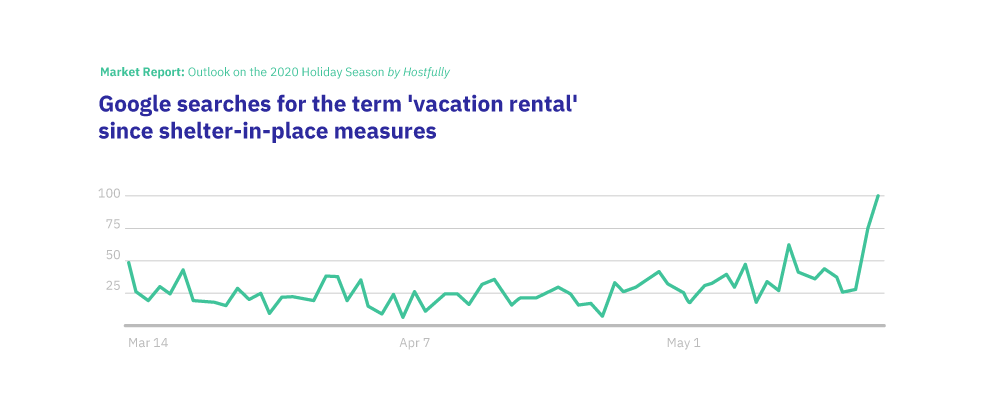
Looking at searches from January 1st to late-May for 2019 and 2020, search interest is considerably higher than it was even a year ago:
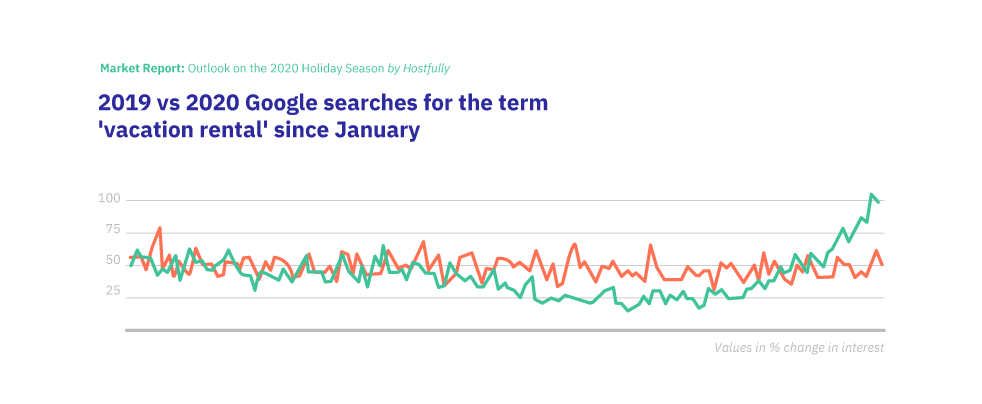
Broadly-speaking, we already see search interest translate into a shift in bookings. In mid-May, Brian Chesky, Airbnb’s CEO, stated that “30 percent of guests are booking stays within 50 miles of their residences, one-third of bookings being made for stays of $50 per night or lower, and 65 percent of reservations being made within one week of the stay.” As Chesky put it, “Near is the new far.”
Search interest: digging a bit deeper
Google and Airbnb data are good starting points, but the vacation rental industry is a nuanced landscape. To provide additional clarity, HomeToGo shared the following based on user search interest on their platform:

Mirroring Airbnb’s findings, HomeToGo’s graph shows a clear spike in domestic travel interest. Although the pandemic forced everyone to slow down, it hasn’t taken away the need for a much-earned break. Guests that worked remotely need a change in scenery from their living space transformed into an office. Or perhaps families are looking for a bit more space for the kids to run around.
HomeToGo dug a bit deeper into the data and found a few other interesting insights:
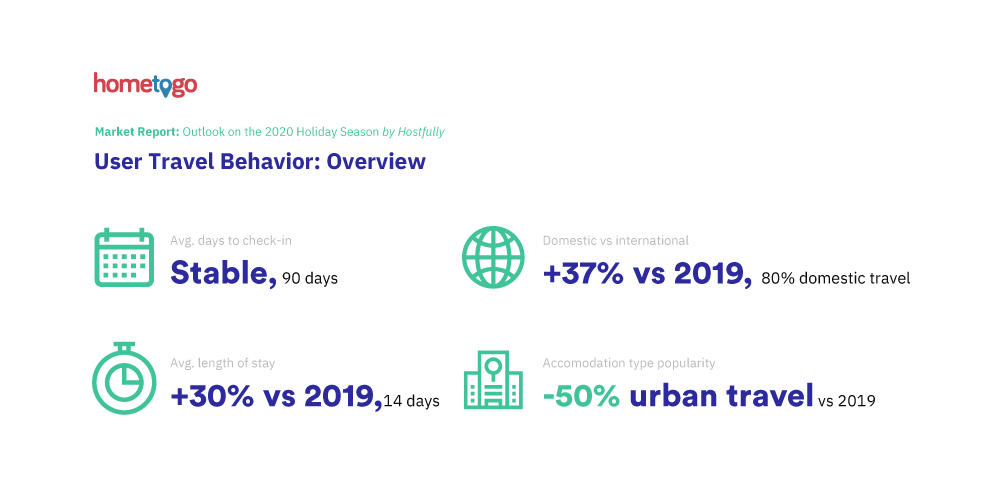
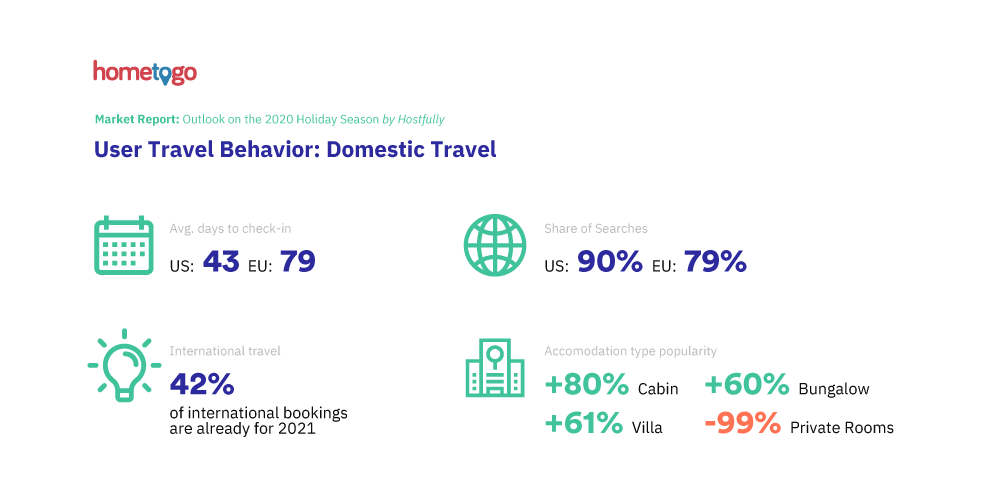
The drop in urban travel is likely a reflection of guest perceptions of the pandemic. For starters, most attractions in urban areas (museums, restaurants, shopping, entertainment) are closed. Second, cities are regional epicenters for the virus and aren’t ideal for physical distancing. Rural destinations are the polar opposite:
- Nature isn’t closed which means hiking, or playing and relaxing outdoors are still options.
- Lower population densities make it easier to stay physically distanced from others.
It’s also interesting to note the preferred accommodation type. Whole houses have gained popularity, which is likely a reflection of the rise in domestic travel demand outside urban areas where such property types are most prevalent.
Occupancy rates are low, but there’s movement
If domestic travelers are looking to travel, how does that translate in booking patterns? AllTheRooms looked at trends in future occupancy rates and came up with this graph:
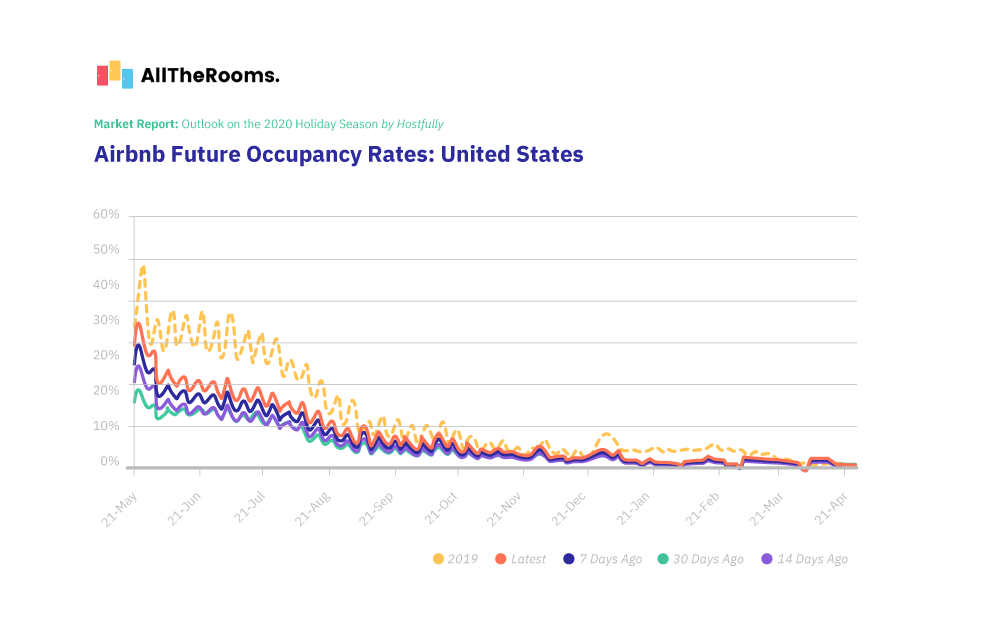
Unsurprisingly, 2020 future occupancy rates are much lower than in 2019 – the high-water mark year of the vacation rental industry. However, there’s still some good news if we focus on certain parts of the graph:
 September through October bookings are still lower than 2019 but not by much. The fact that they haven’t flatlined may be a sign that guests are hopeful the travel industry will normalize in the medium to long-term.
September through October bookings are still lower than 2019 but not by much. The fact that they haven’t flatlined may be a sign that guests are hopeful the travel industry will normalize in the medium to long-term.
 For May and June, near-term occupancy rates are close to 2019 levels. It also shows us that guests appear to be booking near-term reservations (30 days or less), likely for the reasons we previously touched on. People need a break and book on impulse.
For May and June, near-term occupancy rates are close to 2019 levels. It also shows us that guests appear to be booking near-term reservations (30 days or less), likely for the reasons we previously touched on. People need a break and book on impulse.
 Although we’re still far from 2019 occupancy rates, there are still some bookings taking place. Guests want to travel. However, the shroud of uncertainty caused by the pandemic is still weighing on the average traveler’s mind. Guests appear to wait until the last minute to book.
Although we’re still far from 2019 occupancy rates, there are still some bookings taking place. Guests want to travel. However, the shroud of uncertainty caused by the pandemic is still weighing on the average traveler’s mind. Guests appear to wait until the last minute to book.
Top markets attracting domestic US travelers
Knowing that the 2020 hospitality season will pivot around domestic travel, there’s bound to be certain sub-markets that will be more popular with guests. To help understand this trend, Beyond Pricing looked at which spots attracted the most reservation volume:
 Based on this information, we expect to see vacation rental owners and managers who operate beach properties to see a lot of movement this holiday season. That said, cities like Phoenix still draw in their fair share of guests. Areas like Phoenix have abundant space, attractions that aren’t reliant on a downtown core, and most vacation rentals are accessible by vehicle.
Based on this information, we expect to see vacation rental owners and managers who operate beach properties to see a lot of movement this holiday season. That said, cities like Phoenix still draw in their fair share of guests. Areas like Phoenix have abundant space, attractions that aren’t reliant on a downtown core, and most vacation rentals are accessible by vehicle.
The next trend to notice is the representation of East Coast beach destinations. This may be attributed to the long-established East Coast tradition of travel when the seasons change. However, it’s important to remember that much of the North East was under lingering Arctic air, which caused an unusually cold spring. Unlike the rest of North Americans, urban East Coasters had to bundle up if they wanted a change of scenery. It’s no surprise that they’re now craving a bit of sun and warmth.
Beyond Pricing also looked whether a rebound occurred in the domestic vacation rental market. The following shows the relative size of the local market pre-pandemic, during shelter-in-place restrictions and the current value of the market:
 Unsurprisingly, the total value of markets drastically shrunk at the height of the pandemic. This coincides with our own data which showed that cancelations were up 500%. Amidst the uncertainty in the early days of the pandemic, guests didn’t take a chance and canceled their travel plans. However, we’re now seeing a strong rebound in 4 typical vacation rental markets. Taking a step back and looking at the broader US vacation rental market, certain sub-regions have recovered at different rates than others:
Unsurprisingly, the total value of markets drastically shrunk at the height of the pandemic. This coincides with our own data which showed that cancelations were up 500%. Amidst the uncertainty in the early days of the pandemic, guests didn’t take a chance and canceled their travel plans. However, we’re now seeing a strong rebound in 4 typical vacation rental markets. Taking a step back and looking at the broader US vacation rental market, certain sub-regions have recovered at different rates than others:
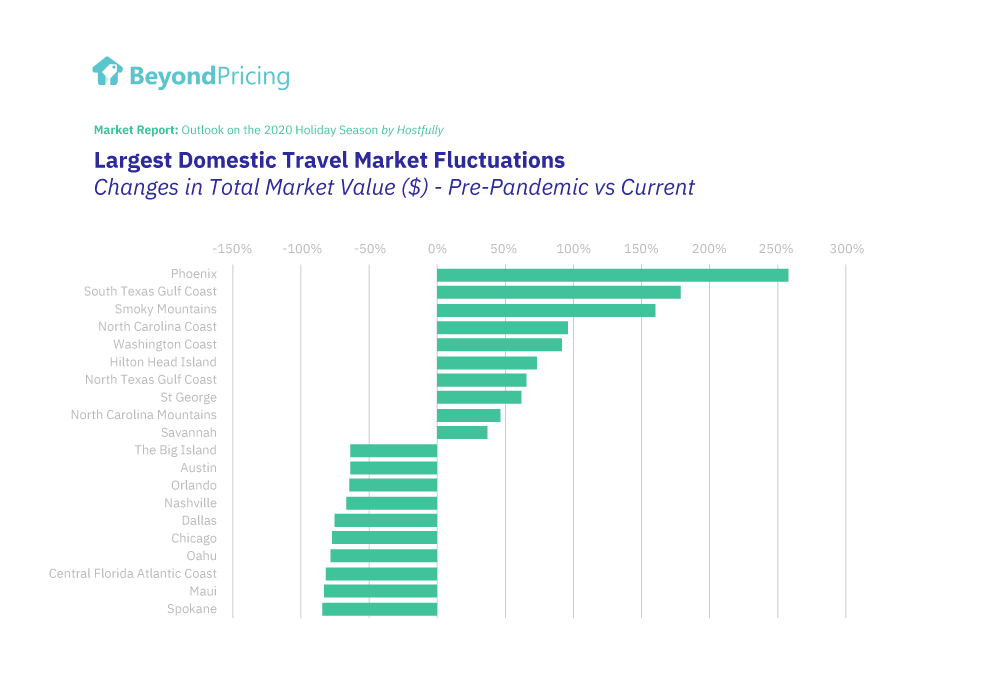
Unfortunately, the vacation rental market in Hawaii is still struggling. This is likely due to the perception by guests that air travel is still unproven given the physical distancing measures recommended by health authorities.
Tactics to capitalize on the rise in domestic travel
Understanding market trends is critical to making the best of the pandemic. However, if your property portfolio is positioned for domestic travelers, you’re likely to face stiff competition from two players:
- Solopreneurs and gig economy hosts: their low overhead costs gives them the flexibility to drop nightly rates. If a race to the bottom starts in your area, you might not be able to keep up. Nor is it appealing: unlike a part-time host, you also have to take into account maintenance.
- Other vacation rental company owners and managers: they’ve taken the same hit you have and are repositioning their operation for the upcoming domestic travel season. However, there’s only so far updating listings and pictures will get you on the major distribution platforms.
So what can you do to capitalize on the public’s newfound interest in domestic travel and outcompete others in your market?
Expand your multi-channel distribution efforts:
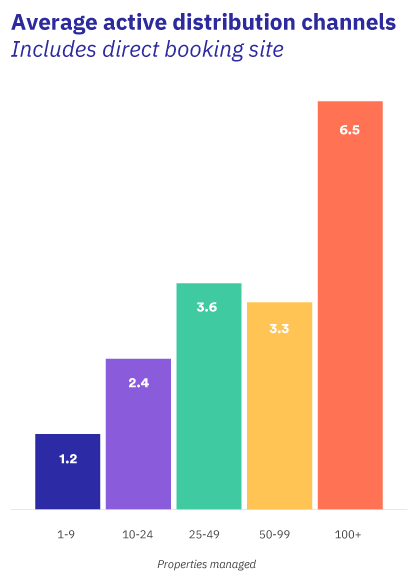 Search interest may be up, but we’re still in a competitive market. Ideally, vacation rental companies should increase their channel distribution to advertise to a broader base of potential guests. If nearby competitors aren’t on one of those channels, you may be the only option for guests using that platform. You can do this in two ways:
Search interest may be up, but we’re still in a competitive market. Ideally, vacation rental companies should increase their channel distribution to advertise to a broader base of potential guests. If nearby competitors aren’t on one of those channels, you may be the only option for guests using that platform. You can do this in two ways:
- Build a direct booking site: Building your vacation rental website can give you an edge by tapping into search engine traffic (instead of relying solely on vacation rental listing sites).
- List on all the major sites: According to our data, most medium-sized vacation rental companies rely on 2-3 vacation rental listing sites to drive bookings their way. So why limit the pool of potential guests? Advertising your properties on all the major booking sites will bring in additional income streams and boost your company’s independence from the major sites.
Learn more about multi-channel distribution (downloadable PDF) – we take a deep look at multi-channel distribution, how vacation rental companies can implement this tactic to decrease vacancies, and which tech solutions can be used to get the job done.
Retarget former guests for a free marketing boost:
Another tactic vacation rental companies can use to boost occupancy rates is to retarget former guests. After all, it’s much easier (and cheaper) to reach out to a known customer than to attract a new one. Owners and managers can also offer discounts to increase the odds of conversion. These discounts don’t necessarily have to be monetary in value. For example, if properties are generally vacant mid-week, the offer could extend the stay for a free night.
Reach out to local tourism stakeholders outside the hospitality industry:
Local tourism boards, business associations, high-end restaurants, and tour operators can sometimes be a great source of referral traffic. A phone call, or a quick email, can be all it takes to get their attention.
What to do if you’re not in a rural, cabin or beach area
So far, all the data for the 2020 holiday forecast points to beach or nature destinations. But what are you supposed to do if you’re operating in a city center? The options are limited, but there are a few tactics available:
1. Focus on your strengths and lean into them for branding
Identify what’s unique about your properties. You can do this by going over guest reviews, or asking a fresh set of eyes for an opinion. From there, you can build a brand for your vacation rental properties that’s consistent across all your distribution channels. Branding will bridge the gap between the professionalism, consistency, and cleanliness of a hotel chain, and the unique benefits of a vacation rental. In the current environment, that extra edge will set you apart from your competition.
2. Expand the reach of your channel distribution
Owners and managers that relied on one or two sites can take advantage of the downtime and duplicate their listings on the other distribution channels. The more sites your vacation rental is listed on, the more chances you will have to convert a booking. This is where great property management software can make a big difference.
3. Capitalize on last-minute travel
As we previously saw, guests are making vacation plans on short notice. You can take advantage of this behavior and increase your odds of converting a booking by decreasing the response time after an inquiry.
4. Change your minimum night stay
Guests may be visiting your area for a short duration. Maybe they’re passing through and need a place for a night, visiting a relative, or on business but want to avoid hotel chains. Lifting your minimum night stay will increase your pool of potential guests.
5. Solve the guest’s ‘travel sticking point’
The virus is on everyone’s mind. Taken from the perspective of potential guests about to travel to a city, hygiene and staying healthy are at the top of their mind. Address that concern the second the guest looks at your listing by documenting and showcasing your new cleaning procedures:
- Make your pictures eye-catching in contrast to your competition. You can do this two ways. Either add a watermark at the bottom of each photo, or include a full-size picture showing that you take cleaning at heart:
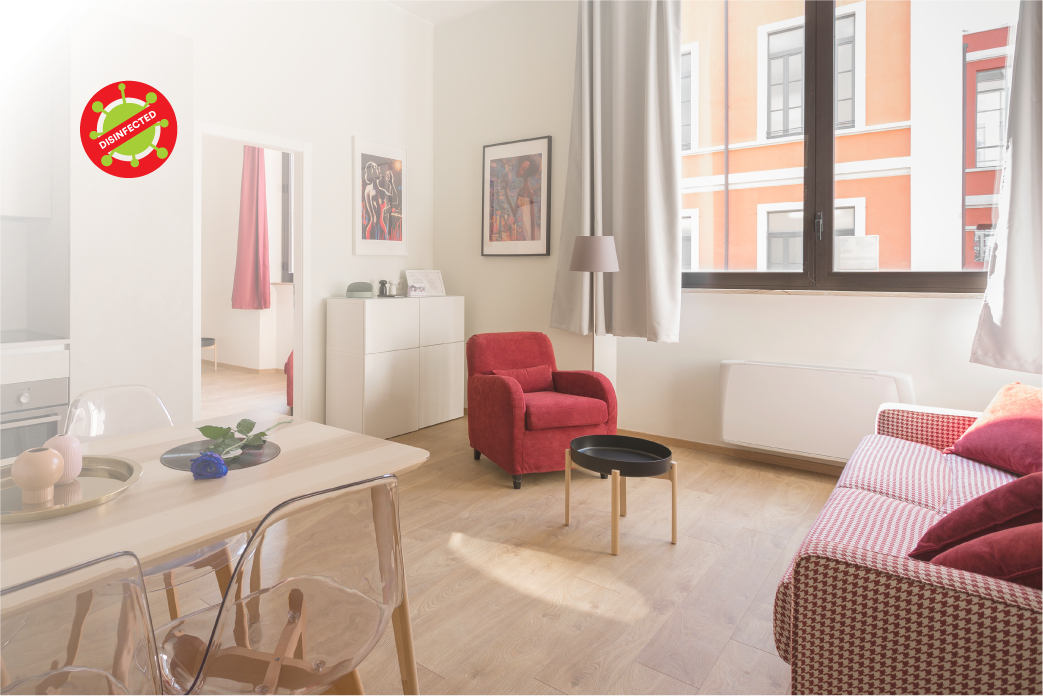

- Update the listing text with your new cleaning measures. Those details should be at the top of the text, followed by your standard description of the property. If guests are worried about staying healthy, your listing should reassure them before anything else.
6. Reach out to nearby hospitals and health authorities
To limit the spread of the coronavirus to their own families, some health professionals are opting to physically distance by living in short term housing. In some cities, vacation rental properties near hospitals saw an increase in bookings from such guests. To tap into this stream of potential guests, contact the non-emergency number of nearby hospitals and health authorities. Explain that you’re a vacation rental owner or manager looking to rent out your properties at a discount for health professionals.
About the contributors

Hostfully is a complete, end-to-end property management platform that helps vacation rental property managers increase bookings and boost revenues. Our Property Management Platform (PMP) streamlines your day-to-day tasks, handles multi-channel distribution, and facilitates guest communications. Our Digital Guidebooks are a novel way to boost the guest experience, decrease in-person meetings, and upsell products and services while guests are in your rental.

AllTheRooms Analytics is the leading provider of short-term rental analytics. As a recognized authority on vacation rental markets, we track the performance of over 12 million properties across more than 200,000 global markets on Airbnb and Vrbo. Our data and analytics provide actionable insights to vacation rental hosts. See what powerful data-driven insights can do for your vacation rental company at AllTheRooms Analytics.


Beyond Pricing was founded by revenue management veterans from the airline and hospitality industries,. It’s the world’s leading revenue management software for vacation rental owners and managers. We provide dynamic pricing through hyper-local analytics to maximize revenue growth. Beyond Pricing has priced billions of dollars in bookings, operates in thousands of markets worldwide, and is integrated with all the major OTAs and property management software systems. See how dynamic pricing can boost your business’ at Beyond Pricing.







